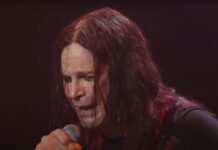After releasing their two most successful albums up until this point, Dark Side of the Moon and Wish You We’re Here, and being at a high point of their popularity, Pink Floyd released their most non-commercial and risky album of their career forty years ago, January 23, 1977. Many music critics didn’t give a positive review for Animals, in fact, one Rolling Stone writer called the album just a laser show looking for a soundtrack. However, many Pink Floyd fans see Animals as their buried treasure which was over shadowed by the success of their more commercial classics and a masterpiece that exemplifies the progressive rock genre.
Animals has a total of five tracks, two tracks less than ninety seconds long and three tracks over ten minutes long, guaranteeing the album received little to no radio airplay. A concept album that delivers a contemptuous account of the social-political situation of late-70s Britain, Animals also presents a slight transformation in style from their earlier work.
Animals was recorded at the band’s studio, Britannia Row, in London, and it was during these recording sessions that a rift between the members would culminate three years later in keyboardist Richard Wright leaving the band, and would later ultimately end the most commercially successful incarnation of Pink Floyd, Roger Waters, David Gilmour, Richard Wright, and Nick Mason. Neither drummer Mason or keyboardist/vocalist Wright contributed as much as they had on previous albums, and guitarist Gilmour was distracted by the birth of his first child, and besides a partial writing credit for “Dogs” contributed little else towards the songwriting of the album. With Wright not contributing much toward Animals, he had this to say about the recording of the album:
“Animals was a slog. It wasn’t a fun record to make, but this was when Roger really started to believe that he was the sole writer for the band. He believed that it was only because of him that the band was still going, and obviously, when he started to develop his ego trips, the person he would have his conflicts with would be me”
Despite what Wright said about Waters taking control of all things Floyd, Waters in complete control of the creative aspect of the band wasn’t initially a bad thing from a fans point of view, which culminated in the release of what was to become the 23rd best selling album of all time, Pink Floyd’s following release, The Wall. However, it was the creative control that Waters enforced on the band, and from Gilmour’s point of view, was “given” during the recording of Animals, that allowed for the fuel that sparked the creative energy for their future masterpiece.
The outset of the recording of Animals ultimately began in 1975, when Pink Floyd bought a three-story block of church halls at 35 Britannia Row in Islington, London UK. Their deal with Harvest Records’ parent company EMI for unlimited studio time in return for a reduced percentage of sales had expired, and they converted the building into a recording studio and storage facility. Its construction took up most of 1975, and in April 1976 the band started rehearsing and recording their tenth studio album, Animals, at the new facility.
“Raving and Drooling” and “You’ve Got to Be Crazy”, two songs which weren’t fully realized conceptually but were previously performed live and considered for the band’s previous release, Wish You Were Here, were reworked as “Sheep” and “Dogs” on Animals to fit the concept of the album, and were separated by another Waters penned track, “Pigs (Three Different Ones)”. The track mostly references Waters’ private life, including his soon to be new wife, Carolyne Anne Christie.
The concept of Animals is loosely based on George Orwell’s political story Animal Farm, in which the album’s lyrics label several classes in society as diverse varieties of animals: the antagonistic dogs, dictatorial and callous pigs, and the “mindless and unquestioning herd” of sheep. The fable concentrates on Stalinism, but the album is actually an evaluation of capitalism, where the sheep rebel to defeat the dogs. The album was fashioned from an assortment of unconnected songs into a concept which enabled the album to demonstrate social and moral decline of humanity, similar to that of the barbaric nature of animals. The following is a track by track analysis of what would become Pink Floyd’s Animals.
“Pigs on the Wing Part 1”
“Pigs on the Wing” is divided into two parts, which are the first and last tracks of the album. Each part contrast Animal’s three other more cynical tracks, and suggest that companionship can help us overcome our flaws.
According to Nick Mason, and confirmed by Waters, it is a love song directed towards Waters’ new wife at the time, Carolyne Anne Christie. She was really the only one of Waters’ friends he had ever met who could hold her own in an argument with Waters. Mason said you had to be “very good with semantics to win an argument against Waters.” Waters allegedly wrote the song because that’s all he had been looking for all along: someone who could stand up to him, an equal.
“Dogs”
The music was written in 1974 by David Gilmour and Roger Waters, with lyrics by Waters, and originally titled “You’ve Got to Be Crazy”. Waters modified the lyrics and altered the lyrics and re-titled it “Dogs”, fitting it into the album’s concept of associating human behavior to animals, “Dogs” focuses on the destructive, callously competitive business world that describes a ruthless and greedy businessman “Club tie and a firm handshake, a certain look in the eye and an easy smile”, while he is all along waiting “to pick out the easy meat…to strike when the moment is right,” stabbing his confidants in the back and taking advantage of the “Sheep”, however later verses portray him as “just another sad old man, all alone and dying of cancer”. Additionally, many verses explore the negative aspects of business life and how it compares to dogs, such as taking chances and being “trained not to spit in the fan”, losing their individuality “broken by trained personnel”, obeying their superiors “fitted with collar and chain”, being rewarded for good behavior “given a pat on the back”, working harder than the other workers “breaking away from the pack” and getting to know everyone but spending less time with family “only a stranger at home”.
“Pigs (Three Different Ones)”
Pigs represent the people who Waters considers the ones with prosperity and control; they also manipulate the rest of society and encourage them to be cruelly competitive and merciless, which, in turn allows the pigs to remain in command. The song’s three verses defines three different “pigs”, the identities of whom remain unknown, however the third verse identifies campaigner Mary Whitehouse as its third “pig”, describing her as a “house proud town mouse” who has to “keep it all on the inside.” In 2016, during the Roger Waters Desert Trip set, “Pigs’ was played with massive images and quotes of Donald Trump projected on screen.
“Sheep”
A parody of Psalm 23 (“The Lord is my shepherd…”) is spoken in the background, however, the words are altered to fit the theme of the track (“Through quiet reflection and great dedication, Master the art of karate”) and “he maketh me to hang on hooks in high places and converteth me to lamb cutlets”. Near the close of the track, the sheep revolt and kill the dogs, but then retire back to their homes, as if they are waiting for a new pack of dogs to control them.
https://youtu.be/3-oJt_5JvV4
“Pigs on the Wing Part II”
“Pigs on the Wing Part II”, carries a theme of hopelessness and segregation that is forced upon the sheep consequential result of the societal pressures which work to separate the masses, a theme developed in the proceeding track, “Dogs”. Waters carries an optimistic theme in the latter portion of the track, exemplifying the strength and emotional protection from the consequence of community among individuals, a security Waters felt upon meeting his new wife, Carolyne.
Once the album was complete work began on its cover. Hipgnosis, designer of the band’s previous album covers, presented three concepts, one of which was a small child finding his parents having sex: “copulating, like animals!” However, all concepts were passed in favor of one designed by Waters. At the time, Waters lived near Battersea Power Station. A view of the structure was selected for the cover of the album, and the band hired a German company, Ballon Fabrik, who construct Zeppelin airships, and the artist Jeffery Shaw to construct a 40-foot porcine balloon in the shape of a pig, in which they named Algie. The balloon was inflated with helium and maneuvered into position, with a gunman ready to fire if it escaped. However, severe weather interfered with the photo shoot and balloon broke free of its anchorages and vanished from sight. The pig then flew over London’s Heathrow Airport, resulting in cancelled flights and pilots also spotted the pig in the air. Later it landed in Kent, UK, and was recovered by a local farmer, who was livid that it had “scared his cows”. Although filming continued over three days, it was images taken during the photo shoot on the first day that were used for the cover of the album.

The tour in support of Animals, the In The Flesh Tour, began in Dortmund on the same day the album was released, with Algie becoming the inspiration for a number of pig themes used throughout the performance. An inflatable pig was floated over the audience, however, for each performance was replaced with a inexpensive and disposable version.
During the tour, relations between the band continued to sour. Waters began arriving to venues alone, and departing at the end of each performance. On one occasion, Wright flew back to England, threatening to leave the band, in which he did soon after. The end of the tour was also a low point for Gilmour, who felt that they had by now attained the success they initially sought, and that there was nothing else they could look forward to, however Water’s later masterpiece The Wall would ultimately denote that thought, but Water’s complete control of the band would still put immense strain on the band’s future endeavors. On the final date of the In the Flesh tour at the Montreal Olympic Stadium, a few raucous and enthusiastic fans in the front row irritated Waters to such a degree that he spat at one of them. Waters later spoke with producer Bob Ezrin and told him of his sense of isolation on the tour, and how he occasionally felt like constructing a wall to detach himself from the crowd, which later became the concept for The Wall.













